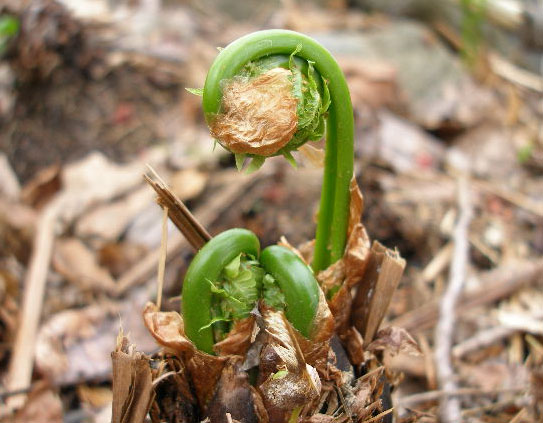Written By Myrhanda .

Another wild delicacy that can be found locally here in Northern Ontario is Fiddleheads.
Fiddleheads, an early spring delicacy throughout the Northeast and Canadian Maritime Provinces, are the young coiled fronds of the ostrich fern (Matteuccia struthiopteris). Nearly all ferns have fiddleheads, but not all fiddleheads are edible.
Identifying:
So how do you identify the Ostrich Ferns?
- The skin is smooth with a deep green colour
- There is a U-shaped groove in the stem similar to the groove in celery.
- They emerge covered in a papery-brown chaff out the black clump called a crown.
- Usually has 6-8 Fronds emerging
- Each frond has a single feather like stem
Don’t be mistaken by another similar fern known as the Bracken Fern (Pteridium Aquilinum) as they’re know to be carcinogenic.

Although they look very similar, it’s easy to tell the difference between the two…
- Brackens only have a single frond
- The frond divides into three branches that are more triangular in appearance.
- Has a fuzzy stem which lacks the U-shaped groove
Ostrich Ferns can be found under hardwood canopies such as Maple or Oak, that provide a dappled light, near rivers or streambeds. They prefer adequate drainage and moisture, but not excessive moisture where they are constantly wet. They like moderate amounts of organic matter with a PH of 5-7, in sandy or silt loams, but not a lot of clay.
Harvesting and Cooking with Ostrich Ferns
You want to harvest the fiddleheads when they’re about 1-2” above the ground. If you wait too long they become quite bitter. To clean them, place them in a colander and thoroughly rinsing/spraying the fiddleheads with clean, cold water. Submerging the rinsed fiddleheads in a bowl of clean, cool water should follow rinsing to remove the remainder of the brown papery coverings, and repeat as needed. It usually takes a few rinses to be cleaned right up, depending on where you found them. Once they are spick and span clean, you can store them in the refrigerator for up to a week before consuming.
There have been a number of foodborne illnesses associated with Fiddleheads (according to Health Canada and the CDC) when consumed raw or lightly cooked. So please please please boil or steam them BEFORE cooking them or preserving them!! If you experience symptoms after eating fiddleheads, you should seek the advice of a health care professional and contact your local public health unit to report this illness.
To boil them, bring lightly salted water in a saucepan or stock pot to a rolling boil and add the cleaned fiddleheads, the water should fully cover the fiddleheads. Bring the water back to a steady boil and boil for 15 minutes. Don’t jam them in there either, allow enough room for the water to thoroughly cook them. If you have to, do them in small batches to mitigate that. To steam them bring a small amount of water to a boil preferably under a stainless-steel, vegetable steamer in a saucepan. Add clean fiddleheads, and steam for 10-12 minutes with a lid covering the steamer and saucepan.
After boiling or steaming, serve at once with optional toppings or seasonings, such as melted butter, vinegar, olive oil, salt or pepper. Cooked and rapidly chilled fiddleheads can be also served as a salad with an onion and vinegar dressing.
For recipes on preservation, please check out the section on Preservation and Recipes
Disclaimer: Do not consume a plant unless 100% of the correct ID. When foraging please make sure if you do not own the land, to ask for permission to enter someone’s property before foraging there. Don’t assume it’s unused property!


